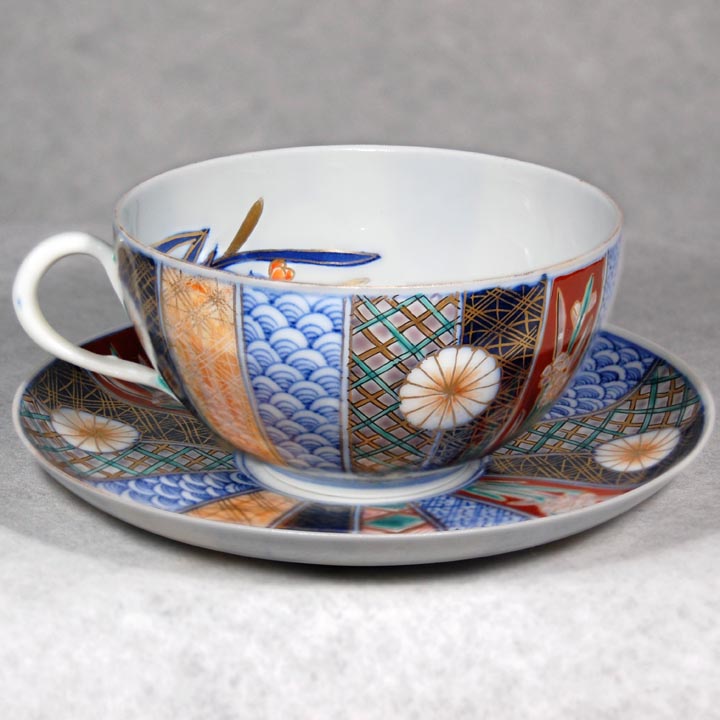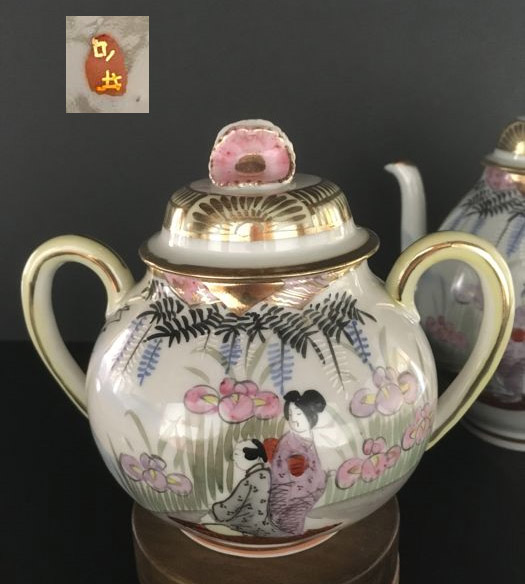
|
Subject:Japanese Eggshell Imari
Posted By: Bill H Thu, Jun 21, 2018 IP: 2601:342:80:4e1c:a84
My stab at identifying the mark on the base of this set came up with 大日本平井製 (Dai Nihon Hirai Seisu). Since Hirai is indicated to be a place or a surname, the mark should translate as "Made by (or at) Hirai in Imperial Japan". Since the "Imperial Japan" part usually denotes Meiji Period (1868-1912), then the lack of a "JAPAN" marking in English would mean a date of 1868-1898 (or before the "JAPAN" mark became effective under U.S. law, by conventional wisdom).
But there may be a problem applying conventional wisdom, because the two orange panels among the chrysanthemum petal shapes have an added luster or lustre that effectively can't be seen in my flat photos. Luster wares from Japan tend to be dated to the early 20th century in most cases I've seen, which aren't all that many. I'm also aware that English lustre wares can date much earlier, more like mid-19th century, so the Japanese at least had a source of the technology to copy.
Anyhow, I'd appreciate comments toward figuring a reasonable date for this C&S set and reconciling the possible conflict vis-à-vis the presence of a luster glaze. Oh, and did I mention verification of the name "Hirai", which ID is based mainly on information from the Japanese Wikipedia.
Dimensions of this set are: Saucer 5.5 inches diameter and cup 4.25 inches across handle X 2-1/16 inches high.
Best regards and many thanks,
Bill H.





|
 Japanese Eggshell Imari
Japanese Eggshell Imari  ( China & Japan ) - Bill H - Jun 21, 2018 (05:58 AM)
( China & Japan ) - Bill H - Jun 21, 2018 (05:58 AM)  Re: Japanese Eggshell Imari - Martin Michels - Jun 21, 2018 (04:12 PM)
Re: Japanese Eggshell Imari - Martin Michels - Jun 21, 2018 (04:12 PM)  Re: Japanese Eggshell Imari
Re: Japanese Eggshell Imari  - Arjan - Jun 21, 2018 (05:23 PM)
- Arjan - Jun 21, 2018 (05:23 PM)  Re: Japanese Eggshell Imari
Re: Japanese Eggshell Imari  - Bill H - Jun 22, 2018 (08:20 PM)
- Bill H - Jun 22, 2018 (08:20 PM)  Re: Japanese Eggshell Imari - Bill H - Jun 24, 2018 (07:17 AM)
Re: Japanese Eggshell Imari - Bill H - Jun 24, 2018 (07:17 AM) 



